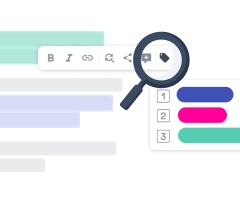
From Invisible to Impactful: How to Prove the Value of User Research
Impact is one of the most talked-about goals in user research, and also one of the hardest to pin down. Everyone wants to do meaningful work, but how do you know it’s actually making a difference? And how do you make sure others know, too?
In a recent virtual meetup, Nikki Anderson, UX Research Consultant and Founder of The User Research Strategist, joined Condens CEO Alexander Knoll to address what every researcher cares deeply about (and occasionally loses sleep over): demonstrating the impact of their work.
Here are the biggest takeaways from their discussion, Plus, real strategies you can use to make sure your research gets the visibility it deserves.
- What Does “Research Impact” Actually Mean?
- The Reality of Doing Impactful Work
- Reactive vs. Proactive Research
- How to Make Generative Research Work (Even When No One’s Asking for It)
- Proving (Not Just Doing) Impact
- Making Research Visible (Be Your Own Marketing Team)
- Final Thoughts: Consistency Builds Recognition
- Watch Recording 🎥
What Does “Research Impact” Actually Mean?
Let’s start with the buzzword itself: Impact.
At its core, impact in the context of user research means enabling better decisions. That includes helping teams move faster, make more confident choices, and reduce risk.
One way to frame it? Think of impact through the lens of usability: effectiveness, efficiency, and satisfaction, just applied to internal decision-making instead of product design.
It’s also helpful to separate the two sides of impact:
Doing impactful work: influencing decisions, unlocking opportunities, shaping outcomes.
Showing that impact: making sure others understand the value research brings.
The two don’t always happen together. Researchers might uncover important insights that quietly influence a product decision, but if nobody knows where that insight came from, the impact gets lost. That’s why visibility and communication are just as important as the research itself.

Takeaway: Keep track of both the outcomes of your work and how it's perceived. Great research deserves recognition!
The Reality of Doing Impactful Work
Every researcher wants to drive impact. But sometimes impactful research doesn’t look impressive on the surface.
Take education for example: onboarding teams to research practices, improving stakeholder understanding, and advocating for the right methods are all deeply valuable and critical building blocks. But the payoff isn’t instant, which can feel frustrating.
Especially in new teams or early-stage research cultures, jumping straight into large generative studies can backfire if the organization isn’t ready. Investing in education, building relationships, and supporting near-term decisions often sets the stage for deeper research later.
„You have to optimize for short-term wins sometimes. That’s what builds trust and opens the door for deeper, more strategic work later.“
Nikki explains that it's about understanding where you are, the context of your organization, and the needs of your stakeholders. That doesn't mean you'll only do tasks like usability testing forever. It means that playing to the advantage of where you are now and gradually expanding your influence lays the foundation for your future success.

Takeaway: Don’t skip foundational work like education or usability studies just because it’s not flashy. It paves the way for the long-term impact you’re aiming for.
Reactive vs. Proactive Research
Research requests often come in hot and fast. The key is to balance reactive research (responding to stakeholder requests) with proactive research (initiating projects based on your own insights and the organization’s strategic needs).
When it comes to reactive research, the key is knowing when to react and when to push back. Not every request deserves to be a project. Instead of reacting to every ask, strong research teams push for context: What’s the underlying problem? What decisions will this research inform? Has something similar been studied before?
If something isn't the best use of time, reframe the conversation. Suggest an alternative approach, and show how it might better support stakeholder goals or organizational priorities.
Proactive projects are valuable too, but riskier. They might not align with current priorities, and there's no guaranteed demand for it.

The sweet spot lies in balancing reactive and proactive work, while always tying it to business goals and organizational momentum.

Takeaway: Objectivity is your superpower. Use it to steer conversations and projects toward more impactful outcomes.
How to Make Generative Research Work (Even When No One’s Asking for It)
Researchers often struggle with getting buy-in for generative research (research that's more exploratory). This is because stakeholders want quick wins and actionable insights — two things generative work can’t always offer on demand.
One practical solution? Sneak it in to the other projects you're working on. Integrate one or two generative questions into other formats, like usability tests. For instance, in a travel app study, you can start by asking: "What inspired your last trip?"
That one question creates space for deeper insight without requiring a standalone project, and it helps stakeholders see the value of broader exploration in a low-effort way.
The key is to make generative research feel relevant, lightweight, and immediately useful.

Takeaway: Don’t wait for permission to add value. Small steps count, and they help educate along the way.
Proving (Not Just Doing) Impact
Measuring impact is tricky, especially when the effects of research play out over time and across teams. Not everything ties neatly to revenue, and not every organization tracks the same KPIs.
Instead of chasing one-size-fits-all KPIs, you can track what matters most for your situation:
- Stakeholder feedback and satisfaction
- Internal process improvements
- Research reuse (yes, avoiding duplicate studies is a valid success!)
- Benchmarking usability metrics like task success and satisfaction scores
You can also track the shift from assumptions to insight: What did the team believe before the study, and what did they understand after? Capturing those changes, even informally, builds a narrative of progress.

Takeaway: Impact isn’t always about money. It’s about enabling better outcomes, whatever that looks like in your context.
Making Research Visible (Be Your Own Marketing Team)
Great research won’t have an impact if no one knows about it.
That means visibility isn’t optional; it’s part of the job. Because visibility builds recognition. And recognition builds momentum.
Sharing findings regularly, documenting what changed as a result of research, and showing up in conversations all help connect the dots for others.
Monthly updates, stakeholder roundups, and even casual Slack messages can reinforce research value. And tracking your work over time, whether in a simple document or a full impact tracker, makes it easier to tell a clear story when it matters most.
„Talk about your work — all the time.“

Takeaway: Share early and often. Education and visibility aren’t a one-time presentation, they’re a continuous, collaborative process.
Final Thoughts: Consistency Builds Recognition
Repetition matters. People often need to hear the same message multiple times before it sticks. That’s true in marketing and research advocacy.
Visibility, education, and tracking impact aren’t one-time tasks. They’re ongoing practices that gradually shift how an organization sees user research.
„Be your own marketing team, essentially!“
Want to make your work harder to ignore? Start small, stay consistent, and keep showing how research makes a difference.
Watch Recording 🎥
This article is based on a UXR Meetup featuring Nikki Anderson and Alexander Knoll, where they explored how to conduct impactful research and prove its value to others.
Get the full recording of the Meetup here:








